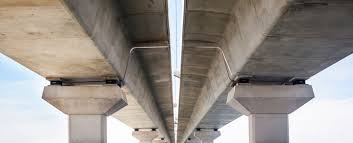views
The bridge bearing market plays a crucial role in global infrastructure development, providing essential components that ensure the stability, safety, and durability of bridges. Bridge bearings serve as the interface between a bridge's superstructure and substructure, distributing loads and accommodating movements caused by traffic, environmental forces, and seismic events. As global infrastructure demands evolve, several key factors are influencing the direction and growth of the bridge bearing market.

Major Factors Impacting the Bridge Bearing Market
1. Global Infrastructure Expansion and Urbanization
One of the most significant factors driving the bridge bearing market is the ongoing expansion of infrastructure worldwide. Rapid urbanization in emerging economies, particularly in Asia-Pacific, Africa, and Latin America, is fueling demand for bridges, highways, railways, and urban mobility projects.
Countries like China, India, Indonesia, and several African nations are investing heavily in transport infrastructure to support population growth, economic development, and regional connectivity. These projects require reliable, high-performance bridge bearings to ensure structural integrity and long-term performance.
Simultaneously, developed nations such as the United States, Canada, and countries across Europe are focused on rehabilitating and modernizing aging infrastructure, further boosting demand for advanced bearing technologies.
2. Technological Advancements in Materials and Product Design
Innovation in materials and engineering design significantly impacts the bridge bearing market. The demand for durable, corrosion-resistant, and low-maintenance components has led to the development of advanced elastomeric bearings, pot bearings, spherical bearings, and disc bearings.
Manufacturers are incorporating high-performance elastomers, stainless steel, advanced polymers, and composite materials to enhance bearing performance under dynamic loads and harsh environmental conditions. Additionally, the integration of smart technologies, including sensors and Internet of Things (IoT) capabilities, allows for real-time structural health monitoring, predictive maintenance, and enhanced safety.
Technological advancements not only improve product reliability but also enable the construction of more complex and resilient bridges.
3. Regulatory Standards and Safety Requirements
The global bridge bearing market is heavily influenced by regulatory frameworks and safety standards. Governments and industry organizations enforce strict quality, testing, and performance guidelines to ensure the safety and longevity of bridge structures.
For instance, standards such as AASHTO (American Association of State Highway and Transportation Officials) guidelines in North America, Eurocodes in Europe, and equivalent national regulations elsewhere mandate rigorous testing and certification of bridge bearings.
Compliance with these standards is essential for manufacturers to participate in public infrastructure projects. As regulations evolve to address new challenges like seismic activity and climate resilience, manufacturers must continually innovate to meet updated safety requirements.
4. Focus on Sustainability and Environmental Impact
The global shift towards sustainable infrastructure development significantly impacts the bridge bearing market. Increasingly, governments and stakeholders prioritize eco-friendly materials, recyclable components, and production processes that reduce environmental footprints.
Bridge bearings made with sustainable materials, corrosion-resistant coatings, and designs that extend service life align with these environmental goals. The adoption of green infrastructure practices and low-maintenance solutions is becoming a crucial differentiator for manufacturers in the market.
Moreover, projects that emphasize climate resilience, including flood- and earthquake-resistant bridge structures, further drive demand for advanced bearing technologies designed with sustainability in mind.
5. Economic Conditions and Infrastructure Funding
Economic fluctuations and government infrastructure spending directly affect the bridge bearing market. During periods of economic growth, public and private sector investments in transportation networks typically increase, driving demand for bridge bearings.
Conversely, economic downturns, political instability, or budget constraints can delay infrastructure projects, temporarily slowing market growth. Global initiatives, such as the U.S. Infrastructure Investment and Jobs Act, China's Belt and Road Initiative, and India's National Infrastructure Pipeline, demonstrate how government-led funding significantly influences market momentum.
Manufacturers and suppliers must remain agile to respond to shifting economic conditions that affect project pipelines and procurement cycles.
Conclusion
The bridge bearing market is shaped by a complex combination of factors, including global infrastructure expansion, advancements in technology, stringent safety regulations, environmental sustainability, and economic conditions. As urbanization accelerates and governments emphasize resilient, future-ready transportation networks, demand for innovative, durable, and low-maintenance bridge bearing solutions is expected to rise steadily.
Manufacturers that invest in advanced materials, smart technologies, and sustainable designs are well-positioned to capitalize on emerging opportunities in this evolving market. With infrastructure projects at the forefront of global development strategies, bridge bearings will continue to play a pivotal role in ensuring safe, reliable, and long-lasting transportation systems worldwide.






















Comments
0 comment